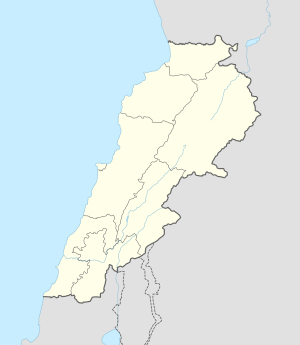Maakne
|
Maqne مقنة Maakne |
|
|---|---|
| Location in Lebanon | |
| Coordinates: 34°4′40″N 36°12′31″E / 34.07778°N 36.20861°ECoordinates: 34°4′40″N 36°12′31″E / 34.07778°N 36.20861°E | |
| Country |
|
| Governorate | Baalbek-Hermel |
| District | Baalbek |
| Time zone | EET (UTC+2) |
| • Summer (DST) | +3 (UTC) |
| Alternate name | Maakne I, Tell Maakne |
|---|---|
| Location | Beqaa Valley, Lebanon |
| Type | Surface site & Tell |
| Part of | Type site |
| History | |
| Periods | Shepherd Neolithic, Early Bronze Age, Ancient Rome |
| Site notes | |
| Excavation dates | 1957 |
| Archaeologists | M. Billaux, Maurice Tallon, Henri Fleisch |
| Condition | ruins, |
| Public access | Yes |
Maqne or Maakne (Arabic: مقنة) is a town and municipality in Baalbek District, Baalbek-Hermel Governorate, Lebanon.
Along with Qaa, Maqne I or Maakne I is a type site of the Shepherd Neolithic industry. The surface site was discovered in 1957 by M. Billaux and the materials found were studied by Henri Fleisch and Maurice Tallon. Findings were published by Fleisch in 1966. The site is located 1 kilometre (0.62 mi) south of the town, east of the road that leads from Baalbek to Homs. The Shepherd Neolithic assemblage found resembled that collected from Qaa and was spread over a sterile area of consolidated Neogene alluvial conglomerates. Lorraine Copeland commented that the industry could be found in no particular concentration around a wide area of the northern Beqaa valley. M. Billaux observed that the worked Shepherd Neolithic flints were of far superior quality than the brittle, unworkable flint conglomerates in the area. He suggested that these flints were imported onto the Beqaa plains from somewhere else.
The Shepherd Neolithic industry can be defined firstly by being small and thick in size, with flakes commonly ranging from 2.5 centimetres (0.98 in) to 4 centimetres (1.6 in), the thickness distinguishing them from geometric microliths. Their second characteristic is the limited number of forms that the tools take, apart from cores being transverse racloirs on small flakes, strong-pointed borers, denticulated or notched thick, short blades and end-scrapers. It was thirdly characterized by a lack of known typology, with only occasional use of Levallois technique. It was determined to be definitely later than the Mesolithic but without any usual forms from the Upper Paleolithic or pottery Neolithic. Henri Fleisch tentatively suggested the industry to be Epipaleolithic and suggested it may have been used by nomadic shepherds. The Shepherd Neolithic has largely been ignored and understudied following the outbreak of the Lebanese civil war.
...
Wikipedia

